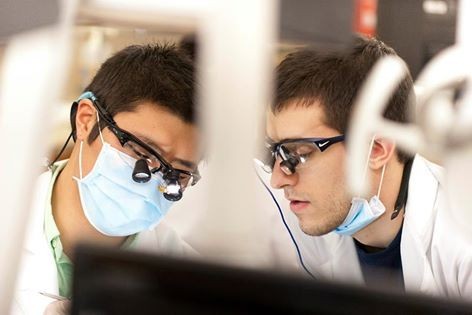
All but one member of the UConn School of Dental Medicine Class of 2016 will start a residency program upon graduation.
Unlike their counterparts in medical school, who are required to complete a residency before they can be licensed to practice, graduating dental students have the option of becoming licensed and going directly into clinical practice.
But this is an option rarely exercised at the UConn School of Dental Medicine.
“Traditionally most dental students in the U.S. do not do residency programs, but at UConn tradition is, and has been for a long time, that we encourage all of our students to consider a residency,” says Dr. Michael Goupil, associate dean for students. “Probably no other dental school has that goal. Here it is the exception for a student not to do a residency. This definitely is atypical of dental schools, but it’s part of our philosophy.”
Another difference from the medical student match process is how dental students learn their residency assignments. While medical students have the tradition of Match Day, when they gather on a specific day in March and open envelopes to reveal their placements, dental students don’t have a single dedicated day. Their specialty determines when they get the news. Some, including those seeking pediatric dentistry, oral surgery or general dentistry programs found out in January. Others, like aspiring endodontists, periodontists and prosthodontics, have known since the fall.
“I was elated! I was called by the program director himself to congratulate me,” says Benjamin Noblitt, who learned on that Jan. 25 phone call that he’s going to the University of Cincinnati for a four-year oral and maxillofacial surgery residency. “Over the course of the day, other residents called to say congrats as well. It was a great feeling to have finally gotten through the process that will allow me to become a surgeon.”
The UConn School of Dental Medicine does hold a residency placement celebration, albeit a less formal one than the medical school’s Match Day, which is held in concert with medical schools across the country.
“I was extremely excited to see where I matched, as it was one of my top choices,” says Patrick Cooper, who was accepted into Harvard’s two-year pediatric dentistry residency at the Boston Children’s Hospital. “The overall process of applying for residency spanned a five-month period, so having a single email let me know my whole future was daunting.”
Nineteen members of the Class of 2016 will enter a residency in general dentistry, while 15 are in specialty programs. Goupil says that’s within the norm for the UConn School of Dental Medicine, as the breakdown is usually close to a 50-50 split between general practice and specialties.
Eleven students are staying in Connecticut for their residencies, four of whom are staying at UConn; 10 are going to New York, and four to Massachusetts. Historically, a majority of students end up practicing close to where they completed their residency program.
“Our students who have gone out from UConn to residency programs do exceptionally well,” Goupil says. “Therefore, residency programs are saying, ‘I know what I’m getting from a UConn student, and I want another UConn student. They perform well.’ The reason we do so well on our residency placement is really based on how our graduates have done with their respective residency programs. They’ve done very well. They’re a known commodity.”
Most dental specialty residencies are two or three years, depending on whether it’s a master’s program. Oral surgery residencies are either four-year certificate programs or six-year M.D. programs.
Most general dentistry residencies are one year. Dan Beauvais was matched to the general practice residency at Saint Francis Hospital and Medical Center, his first choice. It’s a one-year program with an optional second year.
“Advanced training in dentistry gives new dentists a more marketable skill set,” Beauvais says. “Dental school is structured very differently than a private practice, and residencies in general dentistry can facilitate the transition. Residents can benefit from treating patients with complex treatment needs, handling emergency situations, and increasing efficiency and speed.”
Goupil says students come out of dental residencies more confident and more efficient, and that makes them more appealing to prospective employers.
“Traditionally, a dental student sees two patients a day. That’s not the reality of the real world,” Goupil says. “In a residency program, you now are seeing eight to 10 patients a day, so you’ve had to step up your game a little bit to become more efficient about what you do. Now, when you go into private practice, you can be cost effective.”
When aspiring family dentist Brian Wooley enrolled at the UConn School of Dental Medicine, he wasn’t sure whether he would pursue general dentistry or specialize, but he says he knew he’d be well prepared either way.
“UConn has provided me with an excellent medical background as well as the clinical skills necessary to be able to treat both healthy and medically complex patients,” says Wooley, whose next stop is Danbury Hospital for a general practice residency, his top choice. “The faculty also maintained an active role in my residency application process itself.”
One of Goupil’s primary responsibilities is to assist students with the residency application process, which includes facilitating letters from faculty on students’ behalf, practicing interview techniques, and a seminar on writing a CV, offered early in Year 3.
“We have students who come here because they know they want to do a residency and they want to be competitive to get into a residency,” Goupil says.



